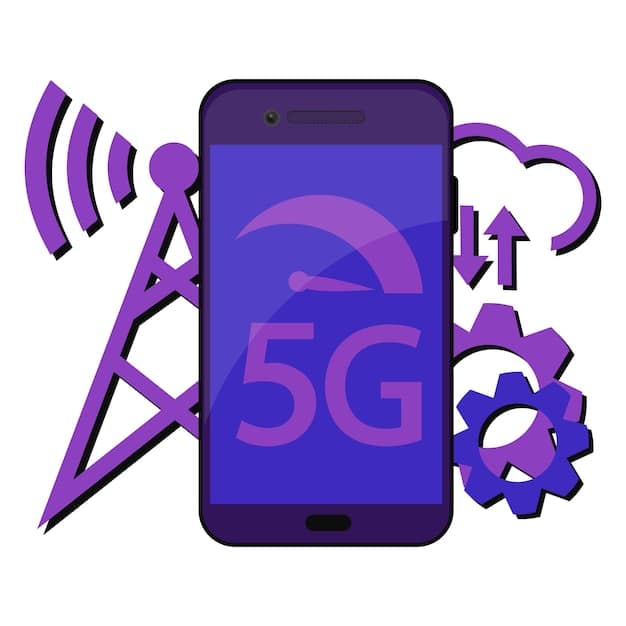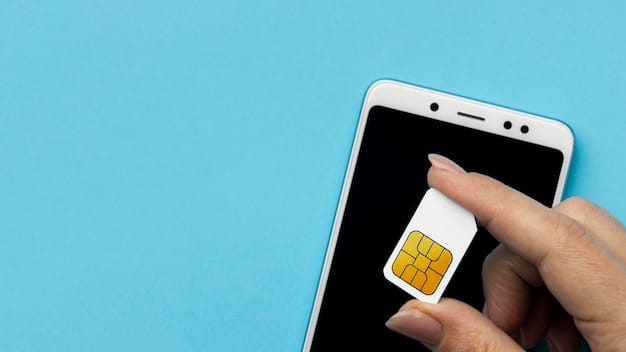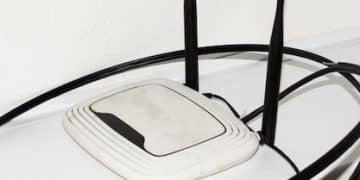Troubleshooting Common 5G Connectivity Issues on Android Devices

Troubleshooting common 5G connectivity issues on Android devices involves various steps, including checking network settings, ensuring software is up to date, and verifying the device’s compatibility with 5G networks, often resolving connectivity issues efficiently.
Experiencing frustrating 5G connectivity issues on your Android device? You’re not alone. Many users face challenges with the latest network technology. This step-by-step guide, troubleshoot common 5G connectivity issues on Android devices, will walk you through proven solutions to get you back online and enjoying seamless 5G speeds.
Understanding 5G Connectivity on Android
5G connectivity offers significantly faster speeds and lower latency compared to previous generations of mobile networks. However, various factors can affect your Android device’s ability to connect to and maintain a stable 5G connection. Understanding these factors is crucial for effective troubleshooting.
Checking 5G Availability in Your Area
5G availability is not universal, and even within areas marked as “5G coverage,” signal strength can vary significantly. Before diving into device-specific troubleshooting, confirm that 5G is actually available in your location.
- Use Coverage Maps: Check your carrier’s website for 5G coverage maps. These maps provide an estimate of 5G availability in different areas.
- Ask Neighbors: Inquire with friends or neighbors using the same carrier about their 5G experience in your area.
- Try a Speed Test: If you can connect to 5G intermittently, run a speed test to verify you’re actually getting 5G speeds.
Confirming 5G availability is the first step in diagnosing connectivity problems. If 5G is not available or has weak coverage, the issue might not be your device but rather the network infrastructure.
Basic Troubleshooting Steps for 5G Connectivity
Before getting into more advanced solutions, start with basic troubleshooting steps. These often resolve simple issues that can prevent your Android device from connecting to 5G.
Restarting Your Android Device
A simple restart can often resolve temporary software glitches that interfere with network connectivity. Power down your device completely, wait a few seconds, and then turn it back on.
Toggle Airplane Mode On and Off
Switching airplane mode on and off resets your device’s network connections. This can help re-establish a connection with the 5G network.
To do this, swipe down from the top of your screen to access the quick settings panel and tap the airplane mode icon to enable it. Wait a few seconds, then tap the icon again to disable airplane mode.
- Force a Network Refresh: Toggling airplane mode forces your device to search for available networks again, which can help it find a 5G signal.
- Resolve Intermittent Connection Issues: If you experience random disconnects from 5G, this quick fix can often restore the connection.
These basic steps are quick and easy to perform and can often resolve minor connectivity issues without requiring more complex troubleshooting.

Checking Your Android’s Network Settings
Incorrect network settings can prevent your Android device from connecting to 5G. Ensure your device is configured to prioritize 5G and to automatically select the best network.
Verifying Preferred Network Type
Your device should be set to prefer 5G networks. Older settings might be set to 4G or LTE, preventing your device from connecting to 5G even when it’s available.
To check and change this:
- Open your device’s settings.
- Go to “Network & Internet” or “Connections.”
- Select “Mobile network” or “SIM card & mobile network.”
- Tap “Preferred network type” and choose “5G/4G/3G/2G” or a similar option that includes 5G.
Enabling Automatic Network Selection
Automatic network selection allows your device to automatically choose the best available network. Disabling this feature can sometimes prevent your device from connecting to 5G.
- Ensure Seamless Transitions: Automatic selection helps your device switch between 5G and other networks smoothly.
- Optimize Connectivity: This setting ensures your device always uses the best available connection.
Checking and adjusting these network settings helps ensure your Android device is properly configured to connect to 5G networks.
Software Updates and 5G Compatibility
Outdated software or incompatible hardware can cause 5G connectivity issues. Staying up-to-date with software updates and verifying hardware compatibility are essential.
Updating Your Android Operating System
Software updates often include bug fixes and improvements to network connectivity. Ensure your Android operating system is up to date.
To check for updates:
- Open your device’s settings.
- Scroll down and tap “System” or “About phone.”
- Select “System update” or “Software update.”
- Follow the on-screen instructions to download and install any available updates.
Checking Device Compatibility
Not all Android devices support 5G. Check your device’s specifications to ensure it is 5G-compatible. You can usually find this information on the manufacturer’s website or in the device’s user manual.
- Verify 5G Bands: Different carriers use different 5G frequency bands. Ensure your device supports the bands used by your carrier.
- Hardware Limitations: Older devices may lack the necessary hardware to connect to 5G networks.
Keeping your software updated and confirming device compatibility are crucial steps for ensuring reliable 5G connectivity.
SIM Card Issues and 5G Connectivity
A faulty or outdated SIM card can sometimes prevent your Android device from connecting to 5G. Properly managing your SIM card is important for maintaining connectivity.
Checking Your SIM Card
Ensure your SIM card is properly inserted and not damaged. A loose or damaged SIM card can cause connectivity issues.
To check your SIM card:
- Power off your device.
- Locate the SIM card tray (usually on the side of the device).
- Use a SIM ejector tool or a paperclip to open the tray.
- Remove the SIM card and inspect it for damage.
- Reinsert the SIM card, ensuring it is properly seated.
- Power on your device.
Contacting Your Carrier for a New SIM Card
If your SIM card is old or damaged, contact your carrier to request a new one. An outdated SIM card might not support 5G connectivity.
- Ensure 5G Support: Confirm the new SIM card is 5G-compatible.
- Activate the New SIM: Follow your carrier’s instructions to activate the new SIM card.
Addressing SIM card issues can often resolve 5G connectivity problems on your Android device.

Advanced Troubleshooting and Resetting Network Settings
If basic troubleshooting steps don’t resolve your 5G connectivity issues, more advanced steps may be necessary, including resetting your network settings.
Clearing Cache and Data for Network Apps
Clearing the cache and data for your device’s network apps can resolve conflicts and improve connectivity. This essentially resets the app to its default state.
To clear cache and data:
- Open your device’s settings.
- Go to “Apps” or “Application Manager.”
- Find and select the network-related apps (e.g., “Carrier Services,” “Mobile Services Manager”).
- Tap “Storage.”
- Tap “Clear cache” and “Clear data.”
Resetting Network Settings
Resetting network settings restores your device’s network configurations to their default values. This can resolve persistent connectivity issues.
- Backup Important Data: Note that resetting network settings will erase saved Wi-Fi passwords and Bluetooth connections.
- How to Reset: Go to Settings > General management > Reset > Reset network settings.
These advanced troubleshooting steps can often resolve complex 5G connectivity issues, but remember to back up any important data before resetting network settings.
| Key Point | Brief Description |
|---|---|
| 📶 Check 5G Availability | Ensure 5G is available in your area using coverage maps or asking neighbors. |
| 📱 Restart Your Device | Restarting can fix temporary glitches affecting 5G connectivity. |
| ⚙️ Verify Network Settings | Ensure preferred network type is set to 5G and automatic network selection is enabled. |
| 🔄 Software Updates | Keep your Android OS updated to ensure compatibility and bug fixes. |
FAQ
▼
Several factors can prevent 5G connection, including your location not having 5G coverage, incorrect network settings, an outdated operating system, or a non-5G compatible SIM card. Always start by verifying these basic elements.
▼
You can check 5G availability by visiting your carrier’s website and using their coverage map. Additionally, you might inquire with neighbors who use the same carrier to verify their 5G experience in your location.
▼
Verify that your preferred network type is set to 5G/4G/3G/2G or a similar option that includes 5G. Also, ensure that automatic network selection is enabled so your device can choose the best available network automatically.
▼
It’s advisable to update your Android OS as soon as updates are available. These updates often include critical bug fixes and improvements to network connectivity, ensuring better performance and security for your device.
▼
Yes, an outdated or damaged SIM card can affect 5G connectivity. Ensure your SIM card supports 5G and is properly inserted. If you suspect your SIM card is the issue, contact your carrier for a new one.
Conclusion
Troubleshooting 5G connectivity issues on your Android device can seem daunting, but by following these step-by-step instructions, you can often resolve common problems and enjoy the benefits of faster 5G speeds. Remember to start with the basic steps and gradually move to more advanced solutions if needed. With a systematic approach, you can diagnose and fix most 5G connectivity issues and stay connected.





